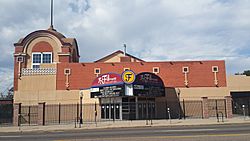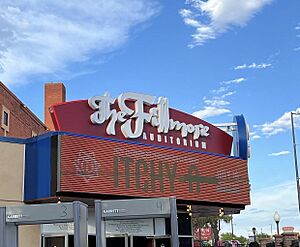Fillmore Auditorium (Denver) facts for kids

Entrance of venue seen from Colfax Avenue (c.2014)
|
|
| Former names | Mammoth Roller Skating Rink (1907–11) Mammoth Garden Roller Club (1935–62) Mammoth Gardens (1969–70; 1981–82) The Market (1976) Mammoth Events Center (1986–99) |
|---|---|
| Address | 1510 N Clarkson St Denver, CO 80218-1419 |
| Location | Capitol Hill |
| Owner | Live Nation |
| Capacity | 3,900 |
| Construction | |
| Opened | 1907 |
| Renovated | 1968, 1986, 1999 |
| Closed | 1917–35; 1970–1976 1976–81; 1982–86 |
| Tenants | |
| Rocky Mountain Rollergirls (WFTDA) (2009-Present) | |
The Fillmore Auditorium, also known as The Fillmore Denver, is a popular concert hall in Denver, Colorado. It's located in the Capitol Hill area. This venue first opened its doors in 1907.
It's the biggest indoor place in Colorado where everyone stands to watch a show. The Fillmore also has a special license. This license lets both younger people and adults over 21 enjoy concerts together. In 2006, a local newspaper called Westword gave it an award. They called it the "Best Place to Run into a Hippie turned Yuppie". The building also has an office for the Bill Graham Foundation. This group helps musicians by giving them money for their projects.
Contents
History of the Fillmore Auditorium
Early Days: Roller Skating and Cars
The building first opened in 1907 as the Mammoth Roller Skating Rink. It quickly became a favorite spot for students from East High School. After the roller rink closed in 1910, a car company moved in. The Fritchle Automobile & Battery Company made almost 500 cars there. One of the first cars was bought by Titanic survivor Molly Brown. The car factory closed in October 1917.
A Community Hub
The building was empty for several years. Then, Irving Jacob bought it and turned it into Denver's first community center. It was called the Mammoth Garden Roller Club. Here, people could go ice skating, play hockey, basketball, and even watch boxing and wrestling. It was also home to the Mammoth Garden Dodgers roller hockey team. A professional basketball team played there too, before the Denver Coliseum was built.
During World War II, the venue was even used for weddings. It also hosted famous "Skating Vanities" shows in 1945–46. The first hockey game ever broadcast on Armed Forces Radio Services came from this building. Games were broadcast every Thursday. The venue also hosted national figure and speed skating championships in the 1950s. In 1960, the famous soul singer James Brown performed its first concert.
From Warehouse to Nightclub
As other venues like the Denver Coliseum became more popular, the Mammoth Garden Roller Club closed. For five years, it was used as a warehouse. In 1968, a concert promoter named Stuart Green bought the building. He changed its name to Mammoth Gardens and turned it into a nightclub. He wanted it to be as popular as other big music venues.
The club worked with another promoter, Barry Fey, to bring famous bands to Denver. Even though it was only open for eight months, many top artists played there. These included Jethro Tull (band), The Who, The Grateful Dead, Johnny Winter, and Joe Cocker. The club closed in October 1970. City leaders wanted it closed to make the area around it better. The building briefly reopened in 1976 as a farmers' market called The Market, but it only lasted four months.
The Mammoth Events Center Era
In 1981, the venue reopened again as "Mammoth Gardens." It hosted sports and music events. It also served as a place for private meetings and parties. After 14 months, it closed again because of problems between the owners. Four years later, Manuel and Magaly Fernandez bought it. After some updates, it became the Mammoth Events Center.
During this time, it became a main spot for Denver's Latin music scene. Many other touring bands also played there. For 12 years, it hosted concerts by groups like The Mighty Mighty Bosstones, Beastie Boys, Ozzy Osbourne, Cyndi Lauper, Pantera, Slayer, Rick James, Cypress Hill, Jane's Addiction, the Offspring, Sublime, Blink-182, Oasis, Coldplay, and Green Day. It also hosted sports events like the Ultimate Fighting Championship and World Championship Wrestling.
The Fillmore Today
In February 1999, Bill Graham Presents bought the venue. This company later joined with Live Nation. The venue then reopened as the Fillmore Auditorium. Some people in Colorado were not happy about this. They felt Denver already had enough music venues. Other places like the Magness Arena, Ogden Theatre, and Paramount Theatre were already popular. Some promoters thought the venue had too many changes over the years. They were not sure if it would be a good place for concerts.
Renovations and Success
Despite these challenges, the building got a big makeover between November 1998 and May 1999. The stage was moved, the sound system was improved, and many new features were added. The first concert at the new Fillmore was by the Trey Anastasio Band on May 19, 1999.
Since then, the Fillmore has become a very important part of Denver's music scene. It has hosted over 1,900 acts. Famous artists like Bob Dylan, Widespread Panic, Foo Fighters, Marilyn Manson, Nelly Furtado, Paramore, Ghost, AJR, and Panic! At The Disco have all played there. Even President Barack Obama visited the venue. Over 2.7 million people have attended events at the Fillmore.
The Fillmore is often ranked as one of America's top 10 clubs for how much money it makes and how many people attend. This is according to Billboard and Pollstar magazines.
In 2017, the Fillmore started a big renovation project. It was the first major update in over ten years. They made the backstage area bigger for artists. They added new green rooms, showers, furniture, and TVs. A full kitchen was also added to serve artists and their crews every night. Another big improvement was adding over 50 new bathrooms for men and women. These changes have received great reviews from newspapers and magazines.


